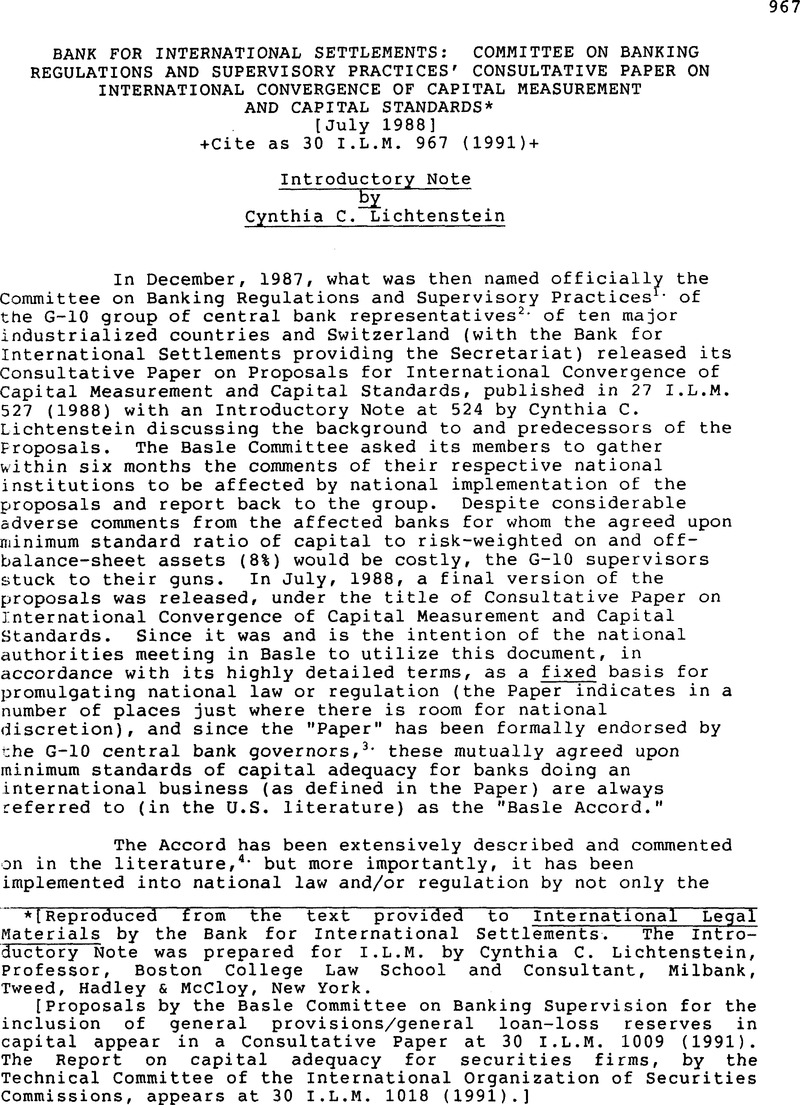Article contents
Bank for International Settlements: Committee on Banking Regulations and Supervisory Practices’ Consultative Paper on International Convergence of Capital Measurement and Capital Standards
Published online by Cambridge University Press: 27 February 2017
Abstract

- Type
- Reports
- Information
- Copyright
- Copyright ©American Society of International Law 1991
References
* [Reproduced from the text provided to International LegaT Materials by the Bank for International Settlements. The Introductory Note was prepared for I.L.M. by Cynthia C. Lichtenstein, Professor, Boston College Law School and Consultant, Milbank, Tweed, Hadley&McCloy, New York.]
[Proposals by the Basle Committee on Banking Supervision for the inclusion of general provisions/general loan-loss reserves in capital appear in a Consultative Paper at 30 I.L.M. 1009 (1991). The Report on capital adequacy for securities firms, by the Technical Committee of the International Organization of Securities Commissions, appears at 30 I.L.M. 1018 (1991).]
1 The Basle Committee on Banking Regulations and Supervisory Practices comprises representatives of the central banks and supervisory authorities of the Group of Ten countries (Belgium,Canada,France,Germany,Italy,Japan,Netherlands,Sweden,Switzerland,United Kingdom, United States) and Luxembourg. The Committee meets at the Bank for International Settlements, Basle,Switzerland.
2 Issued and fully paid ordinary shares/common stock and non-cumulative perpetual preferred stock(but excluding cumulative preferred stock).
3 One member country, however, maintains the view that an international definition of capital should be confined to core capital elements and indicated that it would continue to press for the definition to be reconsidered by the Committee in the years ahead.
4 One member country feels strongly that the lower weight should also apply to other loans secured by mortgages on domestic property, provided that the amount of the loan does not exceed 60 per cent, of the value of the property as calculated according to strict legal valuation criteria.
1 This limit would only apply in the event that no agreement is reached on a consistent basis for including unencumbered provisions or reserves in capital (see paragraphs 20 and 21).
2 Including, at national discretion, allocations to or from reserve during the course of the year from current year's retained profit.
3 This limit would apply in the event that no agreement is reached on a consistent basis for including unencumbered provisions or reserves in capital (see paragraphs 20and21)
1 Includes (at national discretion) gold bullion held in own vaults or on an allocated basis to the extent backed by bullion liabilities.
2 The OECO comprises countries which are full members of the OECD or which have concluded special lending arrangements with the IMF associated with the Fund's General Arrangements to Borrow.
3 Some member countries intend to apply weights to securities issued by OECD central governments to take account of investment risk. These weights would, for example, be 10 per cent, for all securities or 10 per cent, for those maturing in up to one year and 20 per cent, for those maturing in over one year.
4 Commercial loans partially guaranteed by these bodies will attract equivalent low weights on that part of the loan which is fully covered. Similarly, loans partially collateralised by cash or securities issued by OECD central governments and multilateral development banks will attract low weights on that part of the loan which is fully covered.
5 Claims on other multilateral development banks in which G-10 countries are shareholding members may, at national discretion, also attract a 20 per cent, weight.
1 These items are to be weighted according to the type of asset and not according to the type of counterparty with whom the transaction has been entered into. Reverse repos (i.e. purchase and resale agreements where the bank is the receiver of the asset) are to be treated as collateralised loans, reflecting the economic reality of the transaction.The risk is therefore to be measured as an exposure on the counterparty. Where the asset temporarily acquired is a security which attracts a preferential risk weighting, this would be recognised as collateral and the risk weighting would be reduced accordingly.
2 But see footnote 5 in the main text.
3 Instruments traded on exchanges may be excluded where they are subject to daily margining requirements. Options purchased over the counter are included with the same conversion factors as other instruments, but this decision might be reviewed in the light of future experience.
4 Some national authorities may permit individual banks to choose which method to adopt, it being understood that once a bank had chosen to apply the current exposure method, it would not be allowed to switch back to the original exposure method.
5 For interest rate contracts, there is national discretion as to whether the conversion factors are to be based on original or residual maturity. For exchange rate contracts, the conversion factors are to be calculated according to the original maturity of the instrument.
6 Netting by novation as defined in this context is a bilateral contract between two counterparties under which any obligation to each other to deliver a given currency on a given date is automatically amalgamated with all other obligations for the same currency and value date, legally substituting one single net amount for the previous gross obligations.
7 Close out as defined in this context refers to a bilateral contract which provides that, if one of the counterparties is wound up,the outstanding obligations between the two are accelerated and netted to determine the counterparty's net exposure.
8 The other principal form of netting, payments netting, which is designed to reduce the counterparty risk arising out of daily settlements, will not be recognised in the capital framework since the counterparty's gross obligations are not in any way affected.
9 Some member countries reserve the right to apply the full 100 per cent, weight.
- 3
- Cited by




